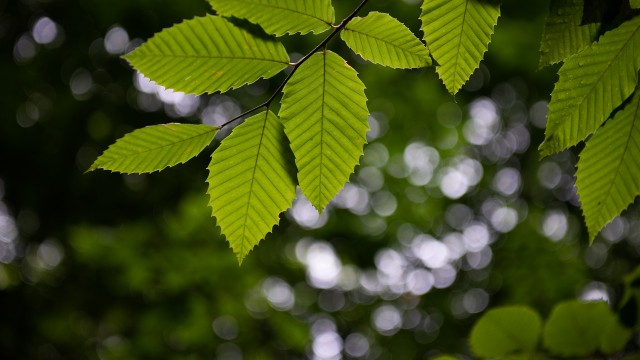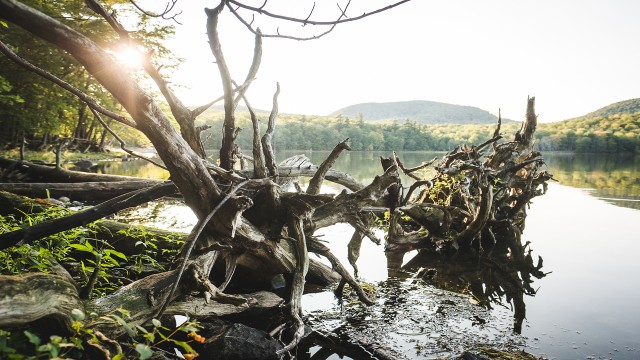The American beech
American beech (Fagus grandifolia) is one of the most iconic and vital tree species found on Mont Saint-Hilaire. Their beautiful, smooth bark makes beech trees a favourite of hikers and landscape painters alike. The American beech is more than its aesthetic beauty, however. It is also an important species for the ecology of our forest. Its numerous, spiky-shelled nuts are a critical food source for squirrels, chipmunks, birds, and insects. American beech branches, canopy, and cavities are an essential home for chickadees and other tree-dwelling species. The unique chemistry of beech leaves makes them especially important for carbon sequestration and soil habitats.
For two organisms, in particular, our beech trees are singularly valuable. While humans and chipmunks rely on the American beech, they can also be found in abundance where it is nonexistent. In contrast, beech scale insects and beech-drops both depend entirely on American beech for nutrition and shelter. They are parasites.
What is a parasite?
A parasite is an organism that lives on or in another host organism and derives its nutrients at the host's expense. Unlike the symbiosis of mycorrhizal fungi, where both mushrooms and plants benefit, only the parasite benefits from this interaction.
In the popular consciousness, parasites are cast as nasty little creatures: tapeworms, the facehuggers of the alien franchise, ticks, etc. These are all pathogenic parasites. Fictional or not, they cause significant harm and disease to their host. However, there are also nonpathogenic parasites. Despite taking resources from their host, these organisms cause no considerable damage to their health.
This may seem unintuitive, but one needs to look no further than our beloved beech trees to see the difference between pathogenic and nonpathogenic parasites.
Beech bark disease
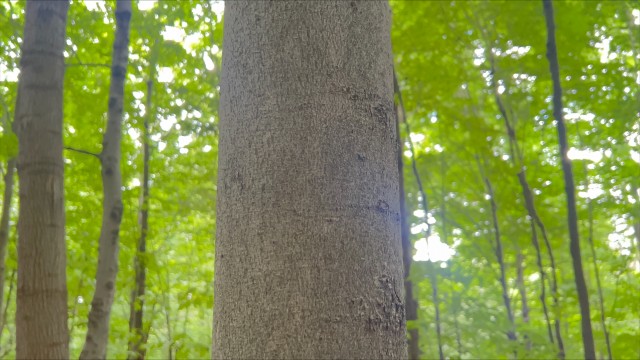
The iconic smooth grey bark of a healthy American Beech Tree (photo: Greg Roberts)
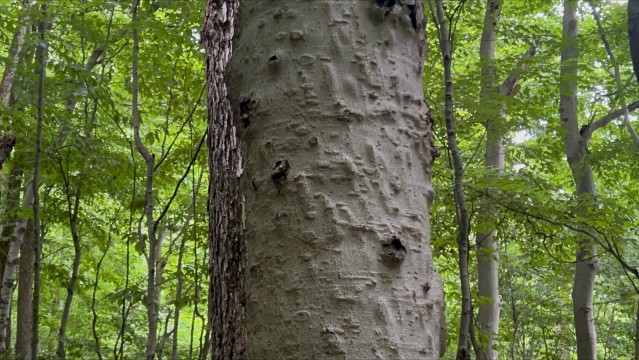
Beech bark disease harms the bark of American beech, drastically changing its appearance (photo: Greg Roberts)
While a healthy American beech trunk is conspicuously smooth and grey, a pathogenic parasite is begun disfiguring them on Mont Saint-Hilaire and across Quebec. Beech scale insects (Cryptococcus fagisuga) are an insect that infests beech bark and feeds extensively on it. Originally native to Europe, this invasive species is especially damaging to native American Beech trees, which lack natural defence mechanisms against infestations.
The impact of beech scale insects is made even worse by opportunistic fungi. Nectaria fungi infect the bark wounds, causing scale at high rates. This combined infection of beech scale insects and fungi causes beech bark disease. With the two infections occurring simultaneously, the trees' immune systems go into overdrive. Around each patch of infection, infected beech trees develop cankers of scar tissue, warping their smooth bark into a crackled ruin.
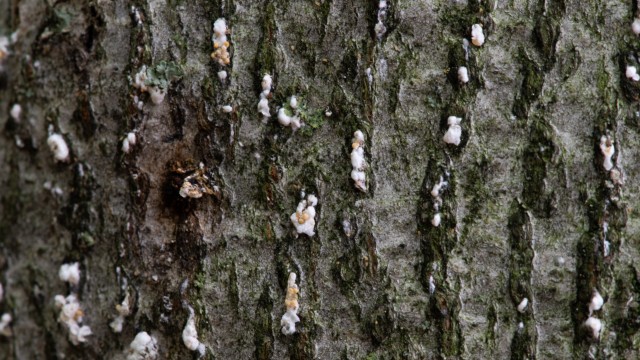
Taking a closer look at the bark of infected beech trees allows us to see the beech scale insects and the fungus responsible for beech bark disease (photo : Alex Tran)
Sadly, beech bark disease causes more than just superficial bark damage. Beech bark disease limits the ability of an infected tree to transport nutrients through its trunk, making it especially vulnerable to other environmental stresses like drought. Normally, beech trees can live to be more than 200 years old. Infected trees are lucky to live longer than 10 years.
Combined with grazing pressure from deer and a shifting climate, beech bark disease threatens the long-term viability of our beloved beech trees and, in turn, the entire composition of our forest.
Beech drops
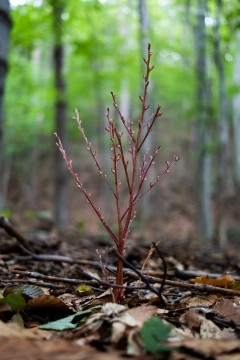
A beech drop colony (photo: Alex Tran)
Turning from the trunk to the roots of the beech trees, one can find another, much friendlier parasite. Beechdrops (Epifagus virginiana) are rather unremarkable at first glance – mistakeable for a simple fallen twig. However, their appearances are quite deceiving. Beechdrops are an extraordinary species found only on beech roots of eastern North America.
Beechdrops are a non-photosynthetic plant that has evolved to get all its nutrients from the root systems of beech tree stands. Rather than getting from the sun like most plants, beechdrops send out specialized structures that puncture beech tree roots and syphon energy from them. This kind of root parasite can sometimes become pathogenic and cause damage or even mortality to the host tree. Thankfully, beechdrops only flower for one season after reaching maturity. They don't stick around long enough to cause lasting harm to their host.
The humble beechdrop is a short-lived, benign cohabitant for an American beech tree. It's like a summer subletter you tolerate but don't care for. For forest managers and researchers, however, it is a wonderfully useful species.
By themselves, beech trees are slow-growing; they take a long time to colonize new environments and grow into mature, healthy forests. Beechdrops take even longer since they can only establish once dense beech root networks are already running through the soil. Because of this long establishing time, scientists use beechdrops as an indicator species for overall forest health. They can only be found in forests, like those on Mont Saint-Hilaire, that have not been recently harmed by intensive human activity.
The future of our forests
As beechdrops and beech bark disease demonstrate, not all parasites are created equal. One of the species presented above (beech scale insects) is a horrible pathogen for American beech trees and the ecosystems and people reliant on them. Meanwhile, the other species (beechdrops) is harmless to the tree and beneficial for research and conservation management.
Beech bark disease, compounded by other environmental pressures, seriously threatens our forests. Beechdrops, however, are a sign of hope that we have not yet lost the fight to save our ecosystems.
Greg Roberts
Field Operations Assistant
Gault Nature Reserve of McGill University
References
- Invasive Species Center. Beech Bark Disease. Invasive Species Centre (blog), 2023.
- Barbara K Andreas, John J Mack, and James S McCormac, “Floristic Quality Assessment Index (FQAI) for Vascular Plants and Mosses for the State of Ohio” (Ohio Environmental Protection Agency, Division of Surface Water, Wetland Ecology Group, 2004).
- Yi-Hsin Erica Tsai and Paul S. Manos. Host Density Drives the Postglacial Migration of the Tree Parasite, Epifagus Virginiana. Proceedings of the National Academy of Sciences of the United States of America 107, no. 39 (September 28, 2010): 17035–40.
- Jessica Turgeon. The Relationship Between Beech Tree Size and Beech Drop Density. The St. Lawrence Lowlands (blog), November 22, 2019.
- Impact of Leaf Litter of Different Tree Species on Soil Chemistry and Biodiversity. CORDIS | European Commission, April 9, 2021.
- American Beech | Ontario.ca, accessed on August 15, 2023.
